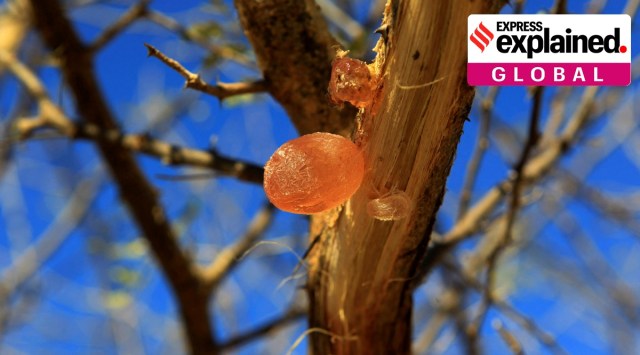Gum Arabic: Why Sudan war could hit your fizzy drinks and candy
About 70% of the world’s supply of gum arabic, for which there are few substitutes, comes from the acacia trees in the Sahel region that runs through Africa’s third-largest country, which is being torn apart by fighting between the army and a paramilitary force.
 Gum arabic is seen on an Acacia trees in the western Sudanese town of El-Nahud that lies in the main farming state of North Kordofan December 18, 2012. (REUTERS/Mohamed Nureldin Abdallah)
Gum arabic is seen on an Acacia trees in the western Sudanese town of El-Nahud that lies in the main farming state of North Kordofan December 18, 2012. (REUTERS/Mohamed Nureldin Abdallah) Sudan’s eruption into conflict has left international consumer goods makers racing to shore up supplies of gum arabic, one of the country’s most sought-after products and a key ingredient in everything from fizzy drinks to candy and cosmetics.
Where is gum arabic found?
About 70% of the world’s supply of gum arabic, for which there are few substitutes, comes from the acacia trees in the Sahel region that runs through Africa’s third-largest country, which is being torn apart by fighting between the army and a paramilitary force.
Wary of Sudan’s persistent insecurity, companies dependent on the product, such as Coca Cola and Pepsico, have long stockpiled supplies, some keeping between three-to-six-months worth to avoid being caught short, exporters and industry sources said. However, prior conflicts have tended to be focused in far-flung regions such as Darfur. This time, the capital Khartoum has been brought to a standstill in the fighting that broke out on April 15, paralysing the economy and disrupting basic communications.
“Depending on how long the conflict continues there may well be ramifications for finished goods on the shelf – branded goods made by household names,” said Richard Finnegan, a procurement manager at Kerry Group, a supplier of gum arabic to most major food and beverage firms.
Finnegan estimated that current stockpiles will run out in five-to-six months, a view echoed by Martijn Bergkamp, a partner at Dutch supplier FOGA Gum who estimated three-to-six months.
What is the current state of the gum arabic trade?
Twelve exporters, suppliers and distributors contacted by Reuters said trade in the gum, which helps bind together food and drink ingredients, has ground to a halt.
Kerry Group and other suppliers, including Sweden’s Gum Sudan, said communicating with contacts on the ground has been difficult and Port Sudan — from where product is shipped — has been prioritising civilian evacuations.
“For companies like Pepsi and Coke, they can’t exist without having gum arabic in their formulations,” Dani Haddad, marketing and development director of Agrigum, a global top-ten supplier, said.
In their manufacturing process, food and drink companies use a spray-dried version of the gum that is powder-like, industry sources said. While cosmetics and printing manufacturers may be able to use substitutes, there is no alternative to gum arabic in fizzy drinks, where it prevents ingredients from separating.
- 01
- 02
- 03
- 04
- 05






































